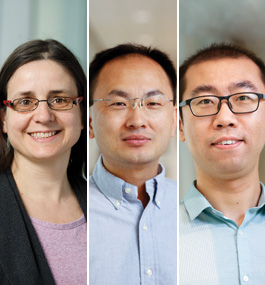Scientists Shift Their Focus to Join the Coronavirus Fight

Tijana Ivanovic, Pengyu Hong and Hongfu Liu
by Lawrence Goodman
With the coronavirus raging around the world, biochemist Tijana Ivanovic, and computer scientists Pengyu Hong and Hongfu Liu are three of the Brandeis researchers bringing their unique approaches and insights to the COVID-19 battle.
A virologist by training, Ivanovic and her team, in partnership with Boston University’s National Emerging Infectious Diseases Laboratories, are using an approach her lab pioneered to study how the virus penetrates a cell’s membrane. She’s also looking at how antibodies produced by the immune system in response to COVID-19 work to inhibit the virus’s membrane penetration.
Ivanovic’s lab will use a technique called total internal reflection fluorescence (TIRF) microscopy to observe the virus-like particles in action. Although TIRF has been around for several decades, her lab is unique in being able to both synthesize virus-like particles and then adapt TIRF to study their behavior.
She hopes a greater understanding of how the virus wreaks havoc in the body will lead to new treatments.
Hong and Liu are using machine learning and artificial intelligence to analyze the genomes of COVID-19, other relevant coronaviruses, avian-influenza viruses and Ebola. They want to identify the bit of COVID-19 genetic code that may give rise to two of the virus’s most lethal attributes: first, its ability to survive in warm weather and, for a relatively long period of time, on surfaces outside host bodies; and second, its long contagious incubation time (about two weeks), during which infected individuals show no or only mild symptoms.
The advanced machine-learning and AI techniques used by Hong and Liu can help sift through massive amounts of data to determine which nucleotide patterns are shared with other infectious viruses and which might be specific to COVID-19.
According to Hong and Liu, AI may also be able to predict emerging variations in the genomes of future viruses, which could allow scientists to identify lethal viruses earlier than at present, or devise treatments and design public health responses in anticipation of a virus’s emergence.
